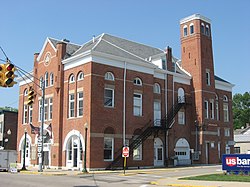2010 census
As of the census [12] of 2010, there were 4,019 people, 686 households, and 411 families living in the village. The population density was 3,139.8 inhabitants per square mile (1,212.3/km2). There were 759 housing units at an average density of 593.0 per square mile (229.0/km2). The racial makeup of the village was 94.4% White, 2.3% African American, 0.1% Native American, 1.1% Asian, 0.3% from other races, and 1.7% from two or more races. Hispanic or Latino of any race were 2.2% of the population.
There were 686 households, of which 26.5% had children under the age of 18 living with them, 47.7% were married couples living together, 9.3% had a female householder with no husband present, 2.9% had a male householder with no wife present, and 40.1% were non-families. 28.4% of all households were made up of individuals, and 12.3% had someone living alone who was 65 years of age or older. The average household size was 2.45 and the average family size was 2.96.
The median age in the village was 21 years. 9.2% of residents were under the age of 18; 66.4% were between the ages of 18 and 24; 8.4% were from 25 to 44; 9.8% were from 45 to 64; and 6% were 65 years of age or older. The gender makeup of the village was 46.5% male and 53.5% female.
2000 census
As of the census [4] of 2000, there were 3,828 people, 681 households, and 420 families living in the village. The population density was 3,594.6 inhabitants per square mile (1,387.9/km2). There were 722 housing units at an average density of 678.0 per square mile (261.8/km2). The racial makeup of the village was 95.06% White, 1.99% African American, 0.39% Native American, 0.81% Asian, 0.03% Pacific Islander, 0.31% from other races, and 1.41% from two or more races. Hispanic or Latino of any race were 0.94% of the population.
There were 681 households, out of which 28.8% had children under the age of 18 living with them, 51.2% were married couples living together, 7.6% had a female householder with no husband present, and 38.2% were non-families. 26.1% of all households were made up of individuals, and 9.1% had someone living alone who was 65 years of age or older. The average household size was 2.55 and the average family size was 3.08.
The village's population primarily consists of college-age students, with 10.4% of residents being under the age of 18, 65.0% from 18 to 24, 10.7% from 25 to 44, 8.4% from 45 to 64, and 5.5% who were 65 years of age or older. The median age was 21 years. For every 100 females there were 85.9 males. For every 100 females age 18 and over, there were 83.8 males.
The median income for a household in the village was $37,200, and the median income for a family was $44,234. Males had a median income of $32,500 versus $22,813 for females. The per capita income for the village was $9,499. About 5.4% of families and 13.8% of the population were below the poverty line, including 5.6% of those under age 18 and 4.3% of those age 65 or over.




